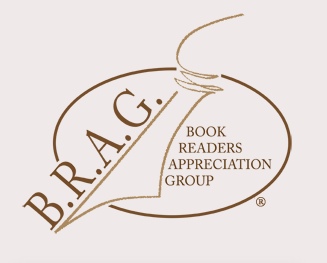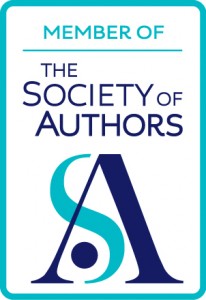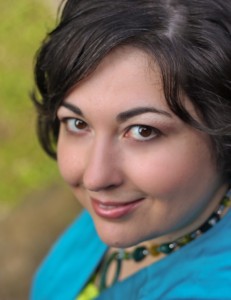 My third guest in the ‘Ravens’ series is Stephanie Dray, whom I had the pleasure of meeting at the Historical Novel Society conference in Denver this summer. Stephanie is a bestselling, multi-published author of historical women’s fiction and fantasy. Her critically acclaimed historical series about Cleopatra’s daughter has been translated into more than six different languages. Before she wrote novels, Stephanie was a lawyer, a game designer and teacher. My third guest in the ‘Ravens’ series is Stephanie Dray, whom I had the pleasure of meeting at the Historical Novel Society conference in Denver this summer. Stephanie is a bestselling, multi-published author of historical women’s fiction and fantasy. Her critically acclaimed historical series about Cleopatra’s daughter has been translated into more than six different languages. Before she wrote novels, Stephanie was a lawyer, a game designer and teacher.
A Year of Ravens was written in collaboration with E. Knight, Ruth Downie, Russell Whitfield, SJA Turney, Kate Quinn and Vicky Alvear Shecter and features seven stories set in the Boudican revolt in Britain 60/61 AD.
Britannia: land of mist and magic clinging to the western edge of the Roman Empire. A red-haired queen named Boudica led her people in a desperate rebellion against the might of Rome, an epic struggle destined to consume heroes and cowards, young and old, Roman and Briton. A Year of Ravens is a novel in seven parts, overlapping stories of warriors and peacemakers, queens and slaves, Romans and Britons who cross paths during Boudica’s epic rebellion. But who will survive to see the dawn of a new Britannia, and who will fall to feed the ravens?
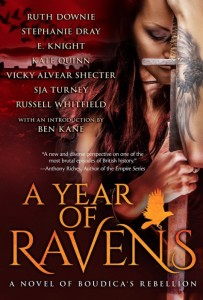 ‘Ravens’ came out last week and is going like a hot cake. I suggest you buy it. (Amazon UK, Amazon US) ‘Ravens’ came out last week and is going like a hot cake. I suggest you buy it. (Amazon UK, Amazon US)
Stephanie’s story is about Cartimandua, Queen of the Brigantes and client of Rome; the surprising thing was that the Romans treated with her at all as she stood for everything against Roman societal norms. She was clever in keeping her people neutral and safe and led a stable and peaceful kingdom (queendom?) for twenty years, whilst the much of Britain was under direct Roman rule. She is remembered negatively for handing over Caratacus to the Romans. Read Stephanie’s story for a different slant…
Welcome to Roma Nova, Stephanie!
Why does Boudicca have an enduring attraction?
For me, the attraction of Boudica’s story is that Romans never seemed to expect women to fight back against them, and it was their blindness in this area that was so often their undoing. Having written several books about Cleopatra’s daughter, I’m fascinated by the twisted relationship Rome had to powerful women, so I’m always drawn to powerful ancient queens who either got in Rome’s way–or learned to get along with them.
Were the group of authors self-selected or chosen? And how did you find working together?
After A Day of Fire, we knew we wanted to get the band back together and work on another collaboration, but because of other professional obligations, Ben Kane and Sophie Perinot couldn’t participate. That gave us an opportunity to reach out to some of our favorite writers. And we’re so glad that we did, because Russ, Simon and Ruth were aces to work with. Each of them brought unique strengths and talents to the project, and they were enormously patient with our brash American ways. Simon’s story in particular features a character that we all ended up using, forcing him to have to tinker every time one of us changed anything in our own stories. Somehow, he did not kill us. In the end, everyone was really dedicated to making the best overall book we could, together. No egos involved. It was very democratic. A lovely experience that makes me feel so honored to have been a part of it.
What do you think is in it for the reader having such a diversity of author styles?
Hopefully, the reader will come away from the book with a different perspective on the entire rebellion than has ever been presented before. Each story is a different facet of a tragic clash of cultures. All of us have our own unique voices and ways of telling a story, but we were all aware of the specific job we needed to do. For example, Kate’s known for her humor and by the time you get to her story you’re going to need a laugh.
Will there be another book focusing on a different event?
We think so. Do you and your readers have a particular event you’d like to see us cover?
Great question! Answers below, please.
Alison Morton is the author of Roma Nova thrillers, INCEPTIO, PERFIDITAS and SUCCESSIO. The fourth book, AURELIA and the Roma Nova box set are now out.
Find out more about Roma Nova, its origins, stories and heroines…
If you enjoyed this post, do share it with your friends!Like this:Like Loading...
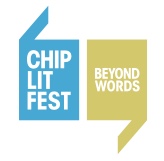 In the pantheon of literary festivals, the Chipping Norton Literary Festival is reckoned to be one of the best: world class speakers, an unrivalled range of events, the ‘localness’ yet global appeal, and not least, enthusiasm and fun. So when I was invited via my writing friend Liz Harris to speak on self-publishing at one of their satellite events, I nearly fell over myself to get to my keyboard to type, ‘YES!’. In the pantheon of literary festivals, the Chipping Norton Literary Festival is reckoned to be one of the best: world class speakers, an unrivalled range of events, the ‘localness’ yet global appeal, and not least, enthusiasm and fun. So when I was invited via my writing friend Liz Harris to speak on self-publishing at one of their satellite events, I nearly fell over myself to get to my keyboard to type, ‘YES!’.
Although I wasn’t asked, I sent in a full proposal detailing what I would speak about, what the participants would learn, and what my experience and credentials were.
Tip: Have this document ready for when the call comes – it creates a professional impression. It needs to be as clear and polished as any other piece of writing.
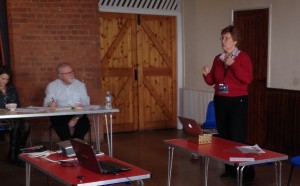 The organiser asked if I would take part in a second talk called ‘Researching your novel’; Liz would talk about general and historical research and I would follow with tips for researching imaginary settings. This didn’t apply only to my Roma Nova series – alternative historical thrillers – but also to science fiction and fantasy writing. The organiser asked if I would take part in a second talk called ‘Researching your novel’; Liz would talk about general and historical research and I would follow with tips for researching imaginary settings. This didn’t apply only to my Roma Nova series – alternative historical thrillers – but also to science fiction and fantasy writing.
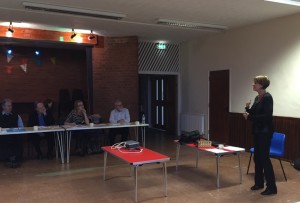 The day starting with Liz talking about plotting and how everything – setting, structure, research, conflict and character – winds into and around it. Despite a technical failure with the projector until halfway through her talk, she carried on gamely from her notes. This was down to two things – she knew her subject and wasn’t spooked by the setback. The day starting with Liz talking about plotting and how everything – setting, structure, research, conflict and character – winds into and around it. Despite a technical failure with the projector until halfway through her talk, she carried on gamely from her notes. This was down to two things – she knew her subject and wasn’t spooked by the setback.
Tip: Practice, practice and practice beforehand and ensure you have prompt cards so you can continue with your talk when a technical failure sends your lovely PowerPoint presentation into the abyss.
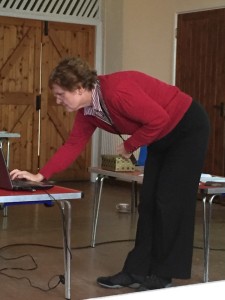 Will it work? Next was our joint session on research. Liz and I knew each other already through the Romantic Novelists’ Association, but we discussed beforehand the structure of the session, how long we’d each speak for and exactly what each of us would be saying.
Tip: If presenting jointly or sitting on a panel, communicate with your fellow speakers well before the day. If you don’t sort out content and running order beforehand, you not only look incompetent, but the audience doesn’t get its money’s worth. When I chaired the self-publishing panel at the Historical Novelist Society conference in Denver this year, I set out ‘rules’ about not mentioning our own books and emphasising the audience’s requirements as well as consulting with them extensively on topics.
Self- or indie publishing is far more complex today and needs forethought and dedication to do it successfully. In my hour’s talk I interspersed the good, the bad and the practical with photos, questions and anecdotes.
Tip: Audiences are keen to hear what you want to say, but keep it snappy and digestible. You do not have to cram everything in.
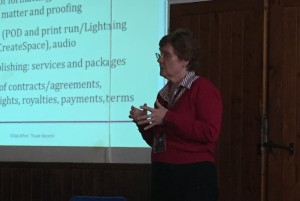 I stressed the twin needs for quality of production and self-started marketing. A few faces blenched at the latter, but I suggested that publishing meant just that – making public! I stressed the twin needs for quality of production and self-started marketing. A few faces blenched at the latter, but I suggested that publishing meant just that – making public!
Tip: Offer handouts as a summary of your talk, further reading or deeper detail of a specific topic covered in your talk. For this session, I gave out notes on the slides, how to choose a publishing services company and social media marketing for authors.
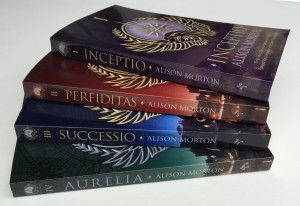 And yes, I took along a small supply of my SilverWood Books published Roma Nova thrillers and my DIY self-published The 500 Word Writing Buddy to show what could be done at different ends of the self-publishing spectrum. And sold both. And yes, I took along a small supply of my SilverWood Books published Roma Nova thrillers and my DIY self-published The 500 Word Writing Buddy to show what could be done at different ends of the self-publishing spectrum. And sold both.
Tip: If the event organiser doesn’t mention selling your books, raise the subject yourself – they probably assumed you would, or they just forgot!
Speaking at events is a way of spreading word of your and your books’ existence, an opportunity to give something back to newer writers and the pleasure of mixing with other writers.
Alison Morton is the author of Roma Nova thrillers, INCEPTIO, PERFIDITAS, SUCCESSIO and AURELIA.
Find out more about Roma Nova, its origins, stories and heroines…
If you enjoyed this post, do share it with your friends!Like this:Like Loading...
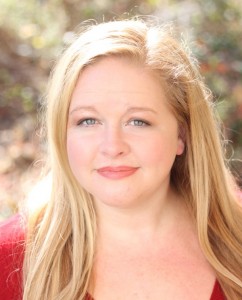 Last week, Russell Whitfield (long time supporter of Roma Nova) told us all about his new collaborative writing project, A Year of Ravens. One of his fellow authors is none other than Kate Quinn, whom I had the pleasure of welcoming to the blog along with the fascinating Vibia Sabina, The Lady of the Eternal City. Not only that, I was delighted (and rather thrilled) to meet Kate and her ‘gang’ (Sophie Perinot, Eliza Knight, Stephanie Dray and Vicky Alvear Schechter) at the Historical Novel Society Conference in Denver. Last week, Russell Whitfield (long time supporter of Roma Nova) told us all about his new collaborative writing project, A Year of Ravens. One of his fellow authors is none other than Kate Quinn, whom I had the pleasure of welcoming to the blog along with the fascinating Vibia Sabina, The Lady of the Eternal City. Not only that, I was delighted (and rather thrilled) to meet Kate and her ‘gang’ (Sophie Perinot, Eliza Knight, Stephanie Dray and Vicky Alvear Schechter) at the Historical Novel Society Conference in Denver.
A Year of Ravens (Amazon UK, Amazon US) came out this week. I suggest you buy it. Now. I’ll be posting my review later, but I do have to say I loved Kate’s story of the Celtic champion and the captured Roman noble, Valeria. Shades of Carina and Aurelia Mitela for this lady’s tough-mindedness and determination in a grim situation! Britain in open, savage revolt wasn’t a safe place in any sense and the Valeria set to to make the best of her situation, something that Kate handled without sentimentality but with great sensitivity.
 A Year of Ravens A novel in seven parts, overlapping stories of warriors and peacemakers, queens and slaves, Romans and Britons who cross paths during Boudica’s epic rebellion. But who will survive to see the dawn of a new Britannia, and who will fall to feed the ravens? A Year of Ravens A novel in seven parts, overlapping stories of warriors and peacemakers, queens and slaves, Romans and Britons who cross paths during Boudica’s epic rebellion. But who will survive to see the dawn of a new Britannia, and who will fall to feed the ravens?
I asked Kate the same questions as Russell and this is what she came up with…
Why does Boudicca have an enduring attraction and why did you choose it as the focus for this book?
It’s not easy picking a topic for a collaboration. You need a historical subject who will equally fascinate seven authors who write very different things; a subject who can provide grist for drama, action, pathos, romance, battle, humor, and everything in between. You need a subject that will hook male and female readers, people who love historical fiction and people who are new to it. Ideally you also want a subject with marquee appeal, a subject with recognition and draw in the name so all people have to do is see the cover to think “oooh!” In fitting all those qualifications, Boudica was a natural fit for us. As a wronged woman, a vengeful mother, a warrior queen, a freedom fighter, and the ultimate pissed-off red-head, she’s a heroine any author can write about and any reader can cheer for.
Were the group of authors self-selected or chosen? And how did you find working together?
Ultimately this project was Eliza’s – she long had a dream of writing a solo book on Boudica’s daughters, but realize her jam-packed writing schedule wasn’t going to allow writing it, so she offered up the topic as a group project to the H Team. And while I’ll always wish I could read the book Eliza would have written on her own, I’m eternally grateful she allowed us to join her on this ride! We had a core four from the Pompeii project – Eliza, Stephanie, Vicky, and myself, and new spaces to fill after pre-existing deadlines took Ben and Sophie out of the line-up. Simon and I were just getting to know each other through social media after he read and reviewed our Pompeii book, so I cajoled him on board. Ruth and Russ were also natural fits; I’ve been a huge fan of their Ruso series and Gladiatrix trilogy respectively, and was so delighted they could join the team. All three of them have been just delightful to work with.
What do you think is in it for the reader having such a diversity of author styles?
A book like this lets all the writers play to their unique strengths. Stephanie writes devious and devastating political machinations with a human angle. Ruth examines the very human side of the Roman occupation and what it meant to live under foreign rule. Russ takes the young growing pains of a great leader and wraps them up in a lot of riveting gore and tragedy. Vicky examines superstition and religious strife and its fallout, and Si takes the immense bloody clash of two warring cultures and makes it deeply personal. I do my best to give the reader a few laughs, right in time for Eliza to do what she does best and tear your heart out with emotional pathos. There’s something for every reader here, whether you like fight scenes or love scenes, political drama or religious strife, witty banter or rousing speeches.
Will there be another book focusing on a different event?
Goodness, I hope so, because writing this book was about the most fun a writer could have and still call it work. We traded approximately three million emails and four million in-jokes, and I’d do it all again in a heartbeat!
Thank you, Kate!
Publication date was 17 November and you can order from Amazon UK and Amazon US now.
Alison Morton is the author of Roma Nova thrillers, INCEPTIO, PERFIDITAS and SUCCESSIO. The fourth book, AURELIA, is now out.
Find out more about Roma Nova, its origins, stories and heroines…
If you enjoyed this post, do share it with your friends!Like this:Like Loading...
 Today, I have a special guest, Russell Whitfield, a true friend of Roma Nova who endorsed INCEPTIO and AURELIA. Russ’s first novel, Gladiatrix, was published in 2008 by Myrmidon Books. The sequel, Roma Victrix, continued the adventures of Lysandra, the Spartan gladiatrix. The third, Imperatrix, released this year, is just simply a tour de force. Today, I have a special guest, Russell Whitfield, a true friend of Roma Nova who endorsed INCEPTIO and AURELIA. Russ’s first novel, Gladiatrix, was published in 2008 by Myrmidon Books. The sequel, Roma Victrix, continued the adventures of Lysandra, the Spartan gladiatrix. The third, Imperatrix, released this year, is just simply a tour de force.
Now, you may remember A Day of Fire six stories about the eruption of Vesuvius in AD 79 which he co-wrote as a highly successful collaborative novel with a group of other historical authors. Well, they’re doing a second one, this time about the Boudican revolt in Britain 60/61 AD, called A Year of Ravens.
Britannia: land of mist and magic clinging to the western edge of the Roman Empire. A red-haired queen named Boudica led her people in a desperate rebellion against the might of Rome, an epic struggle destined to consume heroes and cowards, young and old, Roman and Briton . . . and these are their stories.
- A calculating queen foresees the fires of rebellion in a king’s death
- A neglected slave girl seizes her own courage as Boudica calls for war
- An idealistic tribune finds manhood in a brutal baptism of blood and slaughter
- A death-haunted Druid challenges the gods themselves to ensure victory for his people
- A conflicted young warrior finds himself torn between loyalties to tribe and to Rome
- An old champion struggles for everlasting glory in the final battle against the legions
- A pair of fiery princesses fight to salvage the pieces of their mother’s dream as the ravens circle.
A novel in seven parts, overlapping stories of warriors and peacemakers, queens and slaves, Romans and Britons who cross paths during Boudica’s epic rebellion. But who will survive to see the dawn of a new Britannia, and who will fall to feed the ravens?
 The authors – E. Knight, Ruth Downie, Stephanie Dray, Russell Whitfield, SJA Turney, Kate Quinn and Vicky Alvear Shecter – have all agreed to be guests on this blog over the next few weeks and give their personal take on writing a collaborative project. What a feast! The authors – E. Knight, Ruth Downie, Stephanie Dray, Russell Whitfield, SJA Turney, Kate Quinn and Vicky Alvear Shecter – have all agreed to be guests on this blog over the next few weeks and give their personal take on writing a collaborative project. What a feast!
Today, we’re starting with Russell. The questions will be gentle – no hint of a Roman vigiles punishment officer to carry out the interrogation!
Why does Boudica have an enduring attraction and why did you choose it as the focus for this book?
I think because she’s a woman who kicks serious arse. All the way back to the Ancient Greeks and the Amazons, there’s a fascination with women who step outside of their supposed norm and assume the mantle of the warrior. Hers is the story of the mouse that roared – taking on the Romans and very nearly making them pull out of Britannia is an epic tale in and of itself. As a Romanophile, it’s a strange one for me too, because Boudica is a symbol of British resistance – so I’m a bit torn!
Were the group of authors self-selected or chosen? And how did you find working together?
I was asked to participate in this by Ben Kane and it was a huge honour to be invited as I’m a fan of all the other authors (it’s a small world this writing lark). How’s it been? Great – I know that we’re supposed to say that it was all seamless with no issues – but it really was like that. To be honest, the story that I got to write (about Agricola) was pretty self-contained so there was only a bit of plot crossover, whereas I know many of the other authors were meticulous in getting everything spot on as they referenced each other’s stories. I have to say that this was the most fun though; reading other people’s version of a character that you’d worked on was a great thrill. It was great fun – I loved every moment of this project (well, apart from the editing, cos no one likes that!). No, it was full of ace and awesome.
What do you think is in it for the reader having such a diversity of author styles?
Good question. I hope that people will like it because each story has its own voice. The point of the piece was to show the conflict from many different perspectives so the styles of the writers of course reflect that. The main thing is that Kate Quinn – editor-in-chief and potential member of the Justice League (cos she’s that much of a superheroine) ensured that – crucially – the events flowed well and that the i’s were dotted, t’s were crossed and the piece wasn’t just a bunch of short stories. Not that there’s anything wrong with short stories, but “A Year of Ravens” needed to read and feel like a novel. Thanks to Kate, it does – she chaperoned us all through the hard parts.
The thing is, Kate and all the other writers on this project are amazingly talented people – all writing the same story. It might be a different approach, but these guys are so good that I would imagine that any reader will just get caught up and swept along with it.
Will there be another book focusing on a different event?
I certainly hope so. As I say, this was a huge honour and pleasure for me to be involved in… if there is another one in the future and I’m lucky enough to be invited on board, I’d be there with bells on.
Thank you, Russell!
Publication date is 17 November, but you can pre-order from Amazon UK and Amazon US now.
I’ve been lucky enough to have read a pre-publication copy and will let you know my thoughts later in the series!
Alison Morton is the author of Roma Nova thrillers, INCEPTIO, PERFIDITAS and SUCCESSIO. The fourth book, AURELIA, is now out.
Find out more about Roma Nova, its origins, stories and heroines…
If you enjoyed this post, do share it with your friends!Like this:Like Loading...
 Seasons drive our behaviour whether we like it or not. We no longer live in caves, but in heated and insulated houses with curtains, double-glazing and electric light which weather-proof our lives But am I the only person who tends to ‘hibernate’ in winter and virtually live outside in summer? Seasons drive our behaviour whether we like it or not. We no longer live in caves, but in heated and insulated houses with curtains, double-glazing and electric light which weather-proof our lives But am I the only person who tends to ‘hibernate’ in winter and virtually live outside in summer?
When we write, we must take the season into account. Of course, weather is a wonderful external element; it can belt down with rain in mid-summer and the sun can burst through on a freezing December day. Unexpected or sudden weather can be a gift for a writer as it disrupts the character’s actions wonderfully. More about using weather in your story
Seasons are different. The general rhythm of long summer days and short winter ones in the northern hemisphere where I live is well established, but there are variations between Sweden and Portugal, Ireland and Bulgaria. The nearer the equator, the more equal the days and night, whatever the season. Dusk falls faster the further south you go.
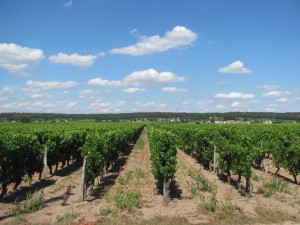 Vines in summer What does this mean for writers? Firstly, establish what season you are in because that will not only give you a clue about the weather but also tell you how light or dark the evenings are. At 6.15pm in October, it’s dusk in south central Europe. However, in June, sunset is around 9pm CET in the same place. So if you want a character in a thriller moving stealthily, check the time when they will be under cover of darkness. A great resource for this, and climate, is http://www.timeanddate.com
Maritime tides are not just affected by the moon, but by seasonal shifts in patterns, e.g. Trade Winds, El Nino, the hurricane season. And check river flows and depths throughout the year.
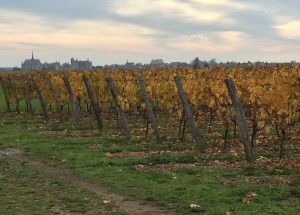 Vines in autumn Green and verdant farmland will be untidy, brown and a tad boring in October/November, but deciduous woodland will be glorious in red and gold. In summer, especially if it’s hot, grass and open spaces can look like the legendary badlands or the Australian bush. Vines, which we all visualise as lush green rows hanging with grapes (aka proto-wine!), stretch for acres of yellow in autumn, then look like bunches of twigs in early January.
Public parks are generally designed with planting resistant to the seasons, but be aware that you will have better line of sight in winter and conversations might not be muffled so well by vegetation during assignations of a romantic or clandestine nature. And if your story takes place in an alpine country or mountains, check the dates of the climbing season and whether the snowline has retreated or advanced.
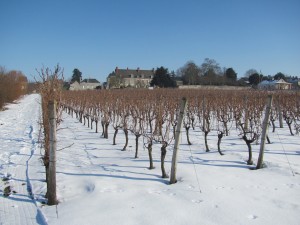 Vines in January snow Transport schedules change between seasons, so don’t count on the no.41 bus coming along for your character all the year round or flights to regional airports being every day. And summer may bring a lot more people to your chosen location as tourists, something that may help or hinder your characters.
Seasons can affect the whole story. In stories set in ancient and medieval periods and into relatively modern times, armies often fought during the ‘campaigning season’ starting in spring after the muddy/snowy/freezing weather which decimated troops through frostbite, hunger and disease had finished. And during the harvest season, desertion was common.
Cold, hot and monsoon seasons bring added misery, or possibly escape for our characters. An out-of-season heat wave or three-metre snowfall can bring transport problems, insects, shortages, communication disruption. And then if everything’s closed for Christmas…
On a more personal level, it could be the time to put out or take in the garden furniture, the first or last drinks evening outside, shutting a beach hut or summer house up for the season, the end of the fishing season. And does your character dread the onset of winter with mist, fog and crisp, dark mornings or welcome the spring when he or she sees bulbs peeping up through the earth? Does it have some symbolism for them, such as the start of a new year, a fresh start?
Alison Morton is the author of Roma Nova thrillers, INCEPTIO, PERFIDITAS and SUCCESSIO. The fourth book, AURELIA, is now out.
Find out more about Roma Nova, its origins, stories and heroines…
If you enjoyed this post, do share it with your friends!Like this:Like Loading...
|
Subscribe to Blog via Email
Join 50 other subscribers.
Categories
Archive
|
 My third guest in the ‘Ravens’ series is Stephanie Dray, whom I had the pleasure of meeting at the Historical Novel Society conference in Denver this summer. Stephanie is a bestselling, multi-published author of historical women’s fiction and fantasy. Her critically acclaimed historical series about Cleopatra’s daughter has been translated into more than six different languages. Before she wrote novels, Stephanie was a lawyer, a game designer and teacher.
My third guest in the ‘Ravens’ series is Stephanie Dray, whom I had the pleasure of meeting at the Historical Novel Society conference in Denver this summer. Stephanie is a bestselling, multi-published author of historical women’s fiction and fantasy. Her critically acclaimed historical series about Cleopatra’s daughter has been translated into more than six different languages. Before she wrote novels, Stephanie was a lawyer, a game designer and teacher. ‘Ravens’ came out last week and is going like a hot cake. I suggest you buy it. (Amazon UK, Amazon US)
‘Ravens’ came out last week and is going like a hot cake. I suggest you buy it. (Amazon UK, Amazon US)













